
Latin Name
Morelia viridis. (Southern race)
Morelia azurea. (Northern race)
Common Name
Green Tree Python.
Adult Size
100cm - 160cm on average, rarely getting up towards 2m.
Distribution
The Green tree python comlex has a large distribution throughout New Guinea and it's numerous surrounding small islands, including the two larger islands of Biak and Japen and also the Aru Islands group.
They are also found in the Cape York peninsular of Australia in the Iron, McIlwraith and Kawadji–Ngaachi ranges. (DJD Natusch, DFS Natusch 2012)
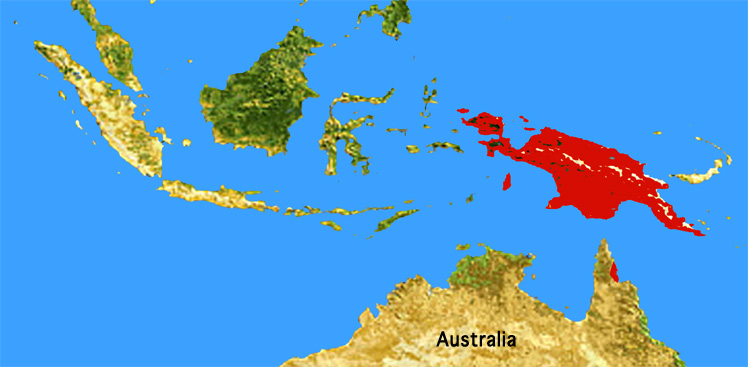
Habitat
Lowland forests and rainforest up to an elevation of 2000m.
Studies show (Wilson, Heinsohn and Legge 2006) that when young, green tree pythons inhabit the forest edge and canopy gaps rather than the closed canopy forest that the adult animals inhabit.
General Description
Commonly known as the Chondro because of it's old scientific name Chondropython viridis, the green tree python was placed in the genus Morelia in 1990 as a single species. (Morelia viridis)
More recent studies (Rawlings and Donnellan 2003) gave evidence that populations found to the north of the dividing mountain range in New Guinea differ significantly from those found to the south and warrants that the species be split into two species.
One of the most recent and comprehensive studies (DJD Natusch et al 2019) supports this two species split and suggests M viridis for animals from Southern New Guinea, the Aru islands and Northern Australia and M azurea for animals from Northern New Guinea. The paper also gives evidence for a three subspecies split of the northern clade azurea.
M a. azurea originating from Biak island, Numfor and Supiori.
M a. pulcher originating from the Vogelkop peninsular.
M a. utaraensis originating from the north of the dividing range.
Irrespective of species or subspecies, green tree pythons are fairly small, slender, arboreal pythons. Adults typically have a green body colour fading to a white, cream or yellow on the belly. They vary in patterns and markings on the body with blue and white patterns and coloured scales along the dorsal and lateral surface. Some adults, especially animals from the island of Biak can retain a large amount of yellow coloration from their juvenile stage.
As a general rule animals found to the north of the dividing mountain range
(M azurea) tend to show more blue markings along the dorsal scales and animals to the south including the Aru islands (M viridis) generally have more white scales along the dorsal with animals from the very southern part of New Guinea and from Australia often showing a full white dorsal stripe. There is however, a great variation in the colour and patterning of the green tree python (although sometimes quite subtle) throughout it's range. The variation between adult and young green tree pythons is even more extreme.
Undergoing an ontogenetic colour change as they mature, young green tree pythons begin life as either yellow or red/ maroon hatchlings. They develop their green coloration between six months and two years of age, although animals from the islands of Biak and Kofiau can often take longer than two years to turn green and will retain a great deal of yellow colour long into adulthood. Again as with the adults there is a difference between the Northern and Southern species with regards to colour. Hatchling M viridis are always yellow however clutches of M azurea can contain red, yellow or maroon coloured hatchlings.
Even though the three images below are of different animals, they clearly show the ontogenetic colour change from hatchling on the left to adult on the right with the intermediate stage in the middle image.
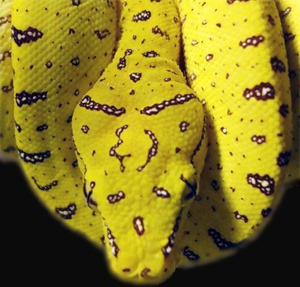
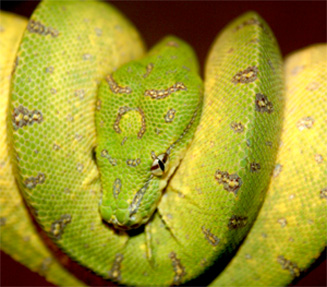
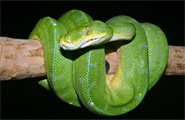
Although not known for sure, it is believed that the difference in adult and juvenile coloration is for camouflage and varies due to the different habitats of the adults and juveniles. The green colour of the adults would help conceal them against leaves in the canopy and the young colours of reds and yellow may help them hide better in shrub and grassland.
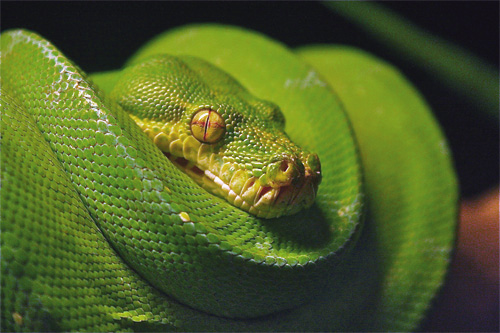
Eye coloration can be varied but the eyes have between one and three coloured lines running though them from nose to neck. These lines follow a line of coloured scales on the head of the snake, as can be seen in the image above and more subtly in the image below.
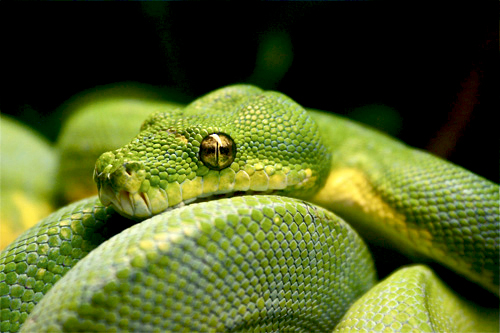
These lines inside the eye are also present and more obvious in animals before the ontogenetic colour change.
An extensive study looking at a large numbers of specimens (DJD Natusch et al 2019) has shown clear morphological differences between species and sub-species.
M viridis and M azurea pulcher have a single line running through the eye as can be see in the image below left whilst M a azurea and M a utaraensis have three lines within the eye as shown in the image below right.
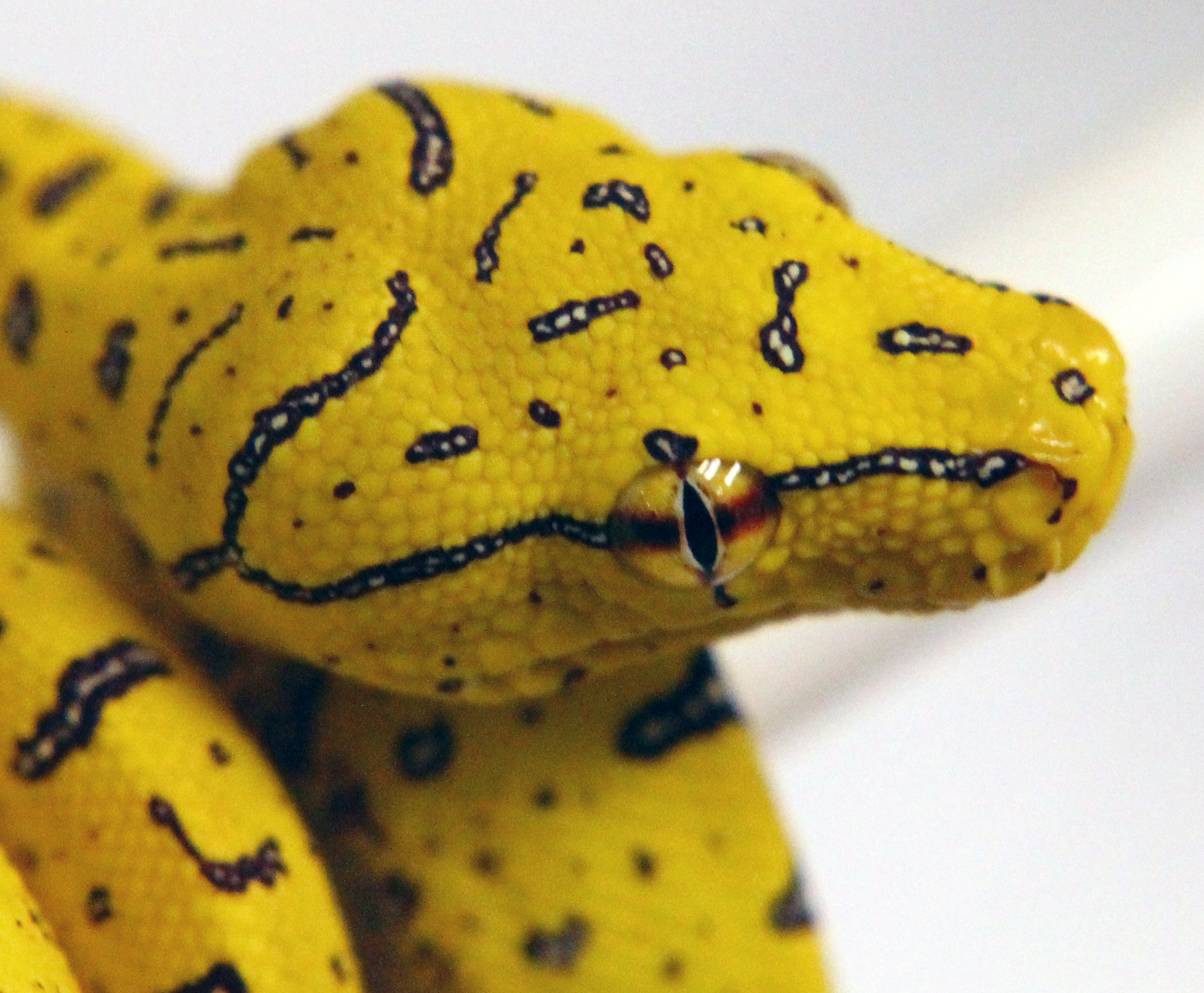
Morelia azurea pulcher
eye detail.
LEFT image.
Morelia azurea azurea
eye detail.
RIGHT image.
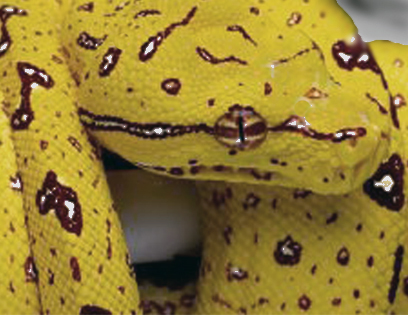
Also shown in the study are differences between the species regarding tail length.
M viridis have shorter more stubby tails whereas M azurea have longer more pointed tails.
When juvenile most green tree pythons tails are darker coloured towards the tip. M. azurea utaraensis is the exception to this and has a lighter coloured tail tip. They use the coloured portion of their tails to caudal lure, wiggling the end of the tail to simulate a small grub or worm in order to entice prey within striking range.
Morelia viridis/azurea are nocturnal and completely arboreal. They spend the daylight hours resting in a characteristic coil draped over branches higher up in the canopy.
At night however they become active and both males and females have been recorded traveling distances of up to 180m in one night. (Wilson, Heinsohn and Legge,2006)
They will travel down from the canopy to wait in ambush for prey at night. Often found within a meter of the ground on a vertical vine or a small tree trunk with their necks in an "S" shape ready to strike at any passing small mammal.
Captive Care
Green tree pythons are fantastic display animals and will often sit in full view in a terrarium when the lights are on. This along with their small slender size means they can be kept in ornate, natural looking terraria creating a focal point to rival the best aquariums. Green tree pythons do require a little more attention to detail in their maintenance compared to, for example a carpet python, especially with regards to humidity when young.
Before going through the main points of captive care, it should be stressed that young green tree pythons (under a year old) are extremely delicate, having especially small delicate bones in their tails and great care should be taken when handling them.
Housing. There are various options as to how you can house your green tree python, including, all glass terrariums, plastic boxes, home built wooden terrariums and commercially made acrylic or plastic terrariums. All these examples have advantages and disadvantages compared with each other such as cost, how well they hold heat / humidity and how easy they are to keep clean.
Young animals tend to do very well in small plastic tubs in a rack style set up for the first six months. The humidity can be easily maintained and this will help keep the tiny snakes hydrated and help them shed well. The substrate can be paper towels as they are easily changed to clean the enclosure and will help keep the humidity up if kept slightly damp. Small plastic perches no larger than the diameter of the snake should be provided and positioned to allow the animal to thermo regulate between the warm and cooler sides of the box.
Once the animals are around six months to a year old and have been feeding well and gained some weight they can be moved into a larger tub or terrarium.
Terrariums are best set up with branches that are the same diameter or thinner than the snakes body with lots of plants (live and/or plastic plants) to give cover over the branches.
If you have to search the terrarium to find and see your young green tree python because of the amount of cover from plants, then the chances are that it can't very easily see you or what is going on outside the terrarium and so will feel secure and not stressed.
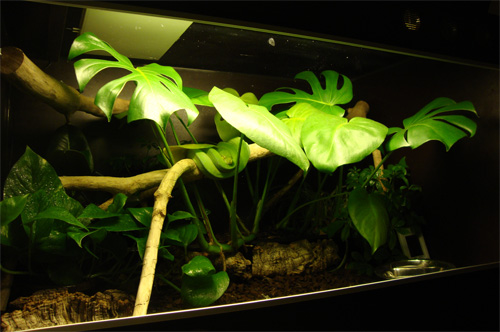
Bark chip substrate will need to be spot cleaned and paper will need to be replaced when soiled.
I keep my adult and sub-adult snakes on a soil substrate that lets me control the humidity in my enclosures at consistent, relatively high levels. There is more information about the soil substrate I use in the terrarium section of this web site.
Perches can be made from plastic pipe or cut branches. If branches are used they can be sealed with varnish to stop them rotting in the high humidity and to allow easier cleaning. Any branches that are going to be varnished need to be fully dried out before coating with varnish.

I use hooks from a local DIY store to fix perches for my arboreal snakes.
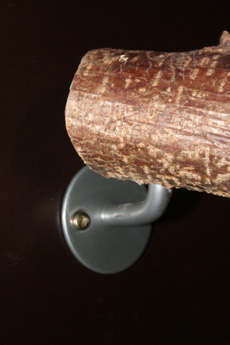
By drilling a hole into the branch that is the same diameter as the hook, branches will sit securely but also be easy to remove for tank maintenance or removing an animal that is resting on a perch.
Humidity.Green tree pythons require quite high humidity, especially very young animals or during shed cycles. This should be provided but care must also be taken not to allow the terrarium to become and remain too wet. Spraying water over the substrate on a daily basis can help keep humidity levels up. The surface of the substrate should be allowed to dry out over the following 24 hrs after spraying. I do not recomend spraying the snake when spraying an enclosure.
Temperature. Green Tree pythons require a temperature gradient within the enclosure. This allows the snake to choose the temperature that it needs at various times. In general the enclosure should have a warm side and a cooler side. Heat can be provided by heat mats, heat panels, heat cable or ceramic heaters. Again there are advantages and disadvantages to each but whichever heating method you choose, it should be controlled by a reliable thermostat. I provide my adult animals with a daytime air temperature gradient of 28 deg C to 24 deg C using heat panels controlled by pulse proportional thermostats. Perches dirrectly under the heat panel reach a temp of 30 deg. At night the air temp gradient drops to 25 deg to 23 deg.
I provide young green tree's with a constant temp gradient of 29 deg at the warm side of their tubs to 25 deg on the cool side with no night time drop.
Lighting. Although nocturnal, green tree pythons will still benefit from some sort of light reaching their enclosure. It can be as simple as making sure the area in the house where they are kept receives some natural light from a window each day or by using artificial lights inside the enclosure. I light my green tree enclosures with LED lights and with full spectrum fluorescent and provide a 12 hour light cycle as this replicates their natural environment. The full spectrum fluorescent also help provide enough light for the plants in the terrariums.
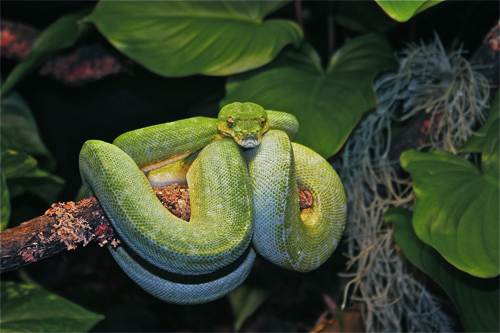
Food. Very young green tree pythons will eat small defrosted pinky mice and can be fed every five days or so provided they are passing waste regularly. As the snakes grow, the size of the mice should be increased and it is a good idea to get them on to fuzzy mice as soon as they can take a meal this size. Once they are big enough to take fuzzy mice I feed around once a week.
Between a year and two years of age feeding can be reduced to around every fourteen days or so. Adults and animals over two years of age can be fed one or more appropriate sized defrosted mice every fourteen days for females and males will be ok if fed every three weeks.
These are just rough guidelines for feeding frequency and feeding less in my opinion is better than feeding more. When thinking about the above schedules I would say that they are the most one should be feeding. However it also needs to be taken into account that animals probably wont eat during shed cycles or for long periods when adult and in breeding condition.
In the wild snakes are opportunistic feeders and food does not come along on a regular schedule. I follow the above feeding schedules very loosely and prefer to watch what the snakes are doing. When they become more active after digesting a previous meal and seem to be actively looking for food I will wait several more days before feeding them again. I don't believe it does the snakes any good to keep feeding them on a set schedule if they are not actively moving around their enclosures at night, as this could eventually lead to an obese snake. Green tree's can get very lazy if they are fed too frequently without moving in between meals.
As a rough guide to how big a meal your tree python will eat, I offer young animals up to two years of age rodents that are up to 15% of their body weight and animals over two years meals up to about 10% but more usually around 5% of their body weight. In my experience 5% seems a good amount for older adult animals to keep good body condition and weight.
Male green tree pythons often stop feeding for long periods once they are around two years of age and older. This is a natural behaviour and one that as a keeper you will have no control over. Once the males become sexually active they will have periods when they roam their enclosures at night but will show absolutely no interest in food. During these times they should still be offered food every couple of weeks but be warned, they will only start to eat again when they are ready.
This leads onto record keeping. It's a good habit to record dates when your snake is fed, when it sheds and to keep track of it's weight. Not only will this go some way towards avoiding the overfeeding of your snake, it can also help show any health issue that might arise before they become problematic.
Please see the points of interest at the bottom of this page for more acurate data on my feeding regimen.
Water.Water should be provided at all times and should be kept fresh. Plastic, glass or metal containers can be used and the water should be replaced a couple of times a week or when soiled. Bowls should be thoroughly cleaned and disinfected every couple of weeks or again when the water has been soiled.
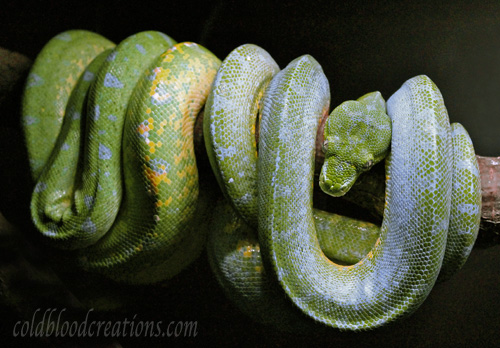
Points of interest.I would like to add some more detail here to the general points above.
First of all a little more information about males going off feed. I have found this can happen at any time of the year although it does seem more common in the autumn and winter months and can last a very long time. The longest period so far, that a male in my care has been off food is 156 days, with another male being close behind with a 150 day fast. The male that fasted for 156 days weighed 505g a couple of weeks after he stopped eating and when he began eating again almost 6 months later weighed 404g. The other male weighed 690g at the start of his fast and dropped to 637g just before he resumed eating. This shows that even though the male snakes can be very active when they fast they don't loose a huge amount of body weight and so frustrating as it can be, it is just another fascinating part of their behaviour.
Here is some more detail of how much and how often I typically feed my green tree pythons.
Snake 1,
Adult 9yr old female (CB2011) during a non breeding year was offered and took 17 meals.
This works out to an average of one meal every 3 weeks throughout the year.
The total weight of the meals for the entire year was 130% of her average body weight.
Average weight of a meal was 7% of her body weight.
Snake 2,
Adult 12yr old male (CB2008) during a non breeding season was offered and took 14 meals.
This works out to an average of one meal every 3.7 weeks throughout the year.
The total weight of the meals for the entire year was 120% of his average body weight.
Average weight of a meal was 8.5% of his body weight.
Snake 3,
Juvenile 0-3yr old female (CB2017)
In the first year was offered and took 37 meals.
This works out to an average of one meal every 10 days throughout the first year.
(A word of note, the average of every 10 days is throughout the year period and takes into account periods where the snake would not eat due to a slough cycle for example. Food was generally offered at various intervals ranging from 4 days to 14 days.)
In the second year was offered and took 26 meals.
This works out to an average of one meal every 2 weeks throughout the second year.
In the third year was offered and took 21 meals.
This works out to an average of one meal every 2.5 weeks.
Another interesting point is the clicking and popping noises these snakes make when they are starting a slough cycle. With young Green tree pythons it can be extremely difficult to tell when they are going to shed. Their skin shows very little sign of being opaque before a shed and sometimes the only visual indication that they are going to shed is a slight swollen look to the head. Animals that have undergone their colour change to green are easier to see when a slough is due as they will turn quite opaque but both adults and young will often make clicking, popping and wheezing noises when they breath a couple of days before turning opaque and up until they shed. These noises sound exactly the same as the noises made when a snake has a respiratory infection. Feeding and shedding records can reduce any worries over these noises as a quick check of a snakes records will show if it is due a slough when these noises are heard rather than being the start of an infection.
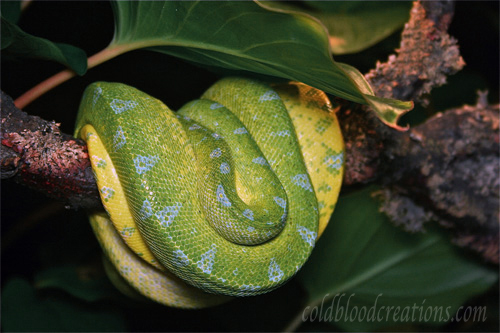
The above information is collected from various sources (click here for references) and from personal observations.
The captive care section is based on how I personally maintain this species. This is not the only way to successfully maintain this species and other keepers use different methods.
This is what works for me, with my animals and the size of collection that I work with.
